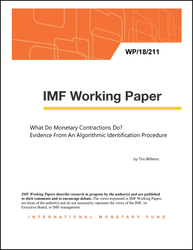
What Do Monetary Contractions Do? Evidence From Large, Unanticipated Tightenings
As the “Volcker shock” is believed to have generated useful information on the effects of monetary policy, this paper develops a simple procedure to identify other unanticipated monetary contractions. The approach is applied to a panel data set spanning 162 countries (over the period 1970-2017), in which it identifies 147 large monetary contractions. The procedure selects episodes where a protracted period of loose monetary policy was suddenly followed by sizeable nominal interest rate increases. Focusing on contractions of significant size increases the signal-to-noise ratio, while they are unlikely to be accompanied by confounding “information effects” (markets interpreting a rate hike as the Central Bank being optimistic about the real side of the economy). A subsequent panel VAR analysis suggests that a 100-basis point rate hike reduces real GDP by 0.5 percent. This reduction in output seems to be persistent, pointing to a certain degree of hysteresis. The price level falls by 1.5 percent, indicating that the medium-/long-run impact of contractionary monetary shocks is not characterized by a neo-Fisherian response. Advanced economies appear to display more price stickiness than emerging/developing countries, as the former combine a more muted price response with a larger effect on output.
Publication date: September 2018
ISBN: 9781484378229
$18.00
Add to Cart by clicking price of the language and format you'd like to purchase
Available Languages and Formats
| English |
Prices in red indicate formats that are not yet available but are forthcoming.
Topics covered in this book
This title contains information about the following subjects.
Click on a subject if you would like to see other titles with the same subjects.
Summary
Copyright © 2010 - 2025
Powered by:
AIDC



